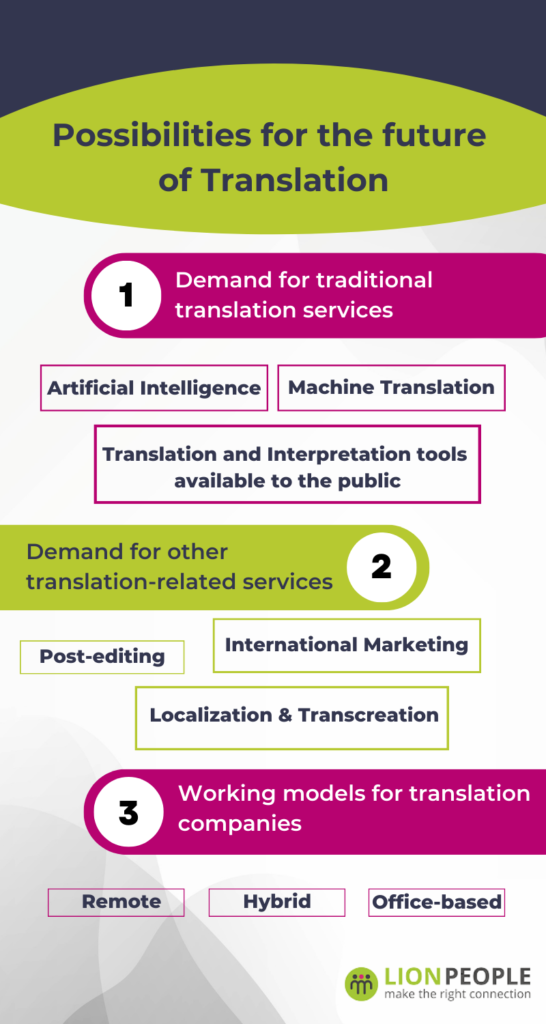Future of Translation
Our ideas of what the future of translation will be like are changing fast.
AI-based machine translation, real-time interpretation tools, hybrid working… There’s a dizzying number of trends and technologies to think about.
It’s obviously very difficult to predict the future for most industries, but there are future possibilities worth considering.
In this blog post, we will explore what these future possibilities are for translation and interpretation.
What is translation?
Translation is simply the process of changing text from one language into text in another language. It is often confused with interpretation, which is spoken translation.
Translation and interpretation have a rich history. The former has likely been practised since writing was first invented and the latter since the dawn of mankind.
The translation industry today
The translation industry as we know it today emerged in the 20th century.
The translation services market doubled in size between 2009 and 2019 and it is predicted to reach a value of over 46 Billion by 2028.
As we move further into the 21st century, it is changing rapidly. Demand, technology, and working models all play a role in this ongoing change.
What are language service providers (LSPs)?
Today, companies involved in translation generally refer to themselves as language service providers (LSPs). This is because they often provide more than translation services. Including:
- Interpretation (both consecutive and simultaneous interpretation)
- Subtitling
- Localization
- Transcreation
Besides translators and interpreters, the typical LSP also employs many other types of workers.
These include translation-specialist project managers, desktop publishing (DTP) experts, marketers, sales managers, and more.
Possibilities for the future of translation
Here is our list of issues and trends that we think could have a big impact on translation, both as a profession and industry.

1. Demand for traditional translation services
The future of languages
The world currently has approximately 7,000 languages. This is less than there was a few decades ago. In fact, one language dies every two weeks.
At present, English is the most spoken language worldwide, with over 1.2 billion speakers. This is because it is the most common second language worldwide.
The language that many believe has the most native speakers is Mandarin. However, according to the Chinese Ministry of Education back in 2014:
30 per cent of our nation’s population does not speak Putonghua [Mandarin], and out of the 30 per cent of the population who possess Putonghua skills, only 1 in 10 can speak Putonghua particularly and fluently.
– Chinese Ministry of Education, 2014
On the other hand, each year approximately 100 million schoolchildren enter the Chinese education system, which educates them in standard Mandarin.
Either way, the trend we see across the globe is towards fewer languages, which in turn might mean less need for translation.
Of course, trends can change. Linguistic diversity will be interesting to observe in the next few decades.
Artificial Intelligence and machine translation
Like many other industries, translation has been deeply changed by technology in recent years.
Translation memories, Computer-Assisted Translation (CAT) tools and machine translation have all already drastically increased translators’ processes and output.
According to recent research by ProZ, the percentage of translators that use at least one CAT tool has grown from 80 – 91% in the past 10 years, for example.
And technologies driven by artificial intelligence (AI), such as natural language processing and machine learning, are becoming increasingly powerful tools for both translators and interpreters.
AI can help automate many translation-related tasks, such as text recognition or document translation.
It is highly likely that the future of translation will be shaped by advances in AI even more than the technology that came before it.
Many people are even asking whether machines will eventually replace human translators and interpreters altogether.
Translation and Interpretation tools available to the public
In the future, translation technology won’t just be available to translation professionals.
The general public is also likely to gain access to translation systems and tools that may reduce or deplete their need for human translation.
Google Translate alone has already taken an enormous amount of work away from the translation industry…
In 2022, Mark Zuckerberg’s Meta (formerly Facebook), previewed their AI interpretation tool. It currently only translates between spoken Hokkien and English, but it could eventually have the potential to cover thousands of language pairings.
Elon Musk’s Nueralink brain chip is aiming to go even further than this. Musk declared back in 2021 that we are 5 – 10 years from Nueralink making language obsolete!
Nueralink plans to do this by enabling users to essentially directly communicate thoughts with a kind of digital telepathy method. This would cut out the step we currently automatically take when we translate our thoughts into words…
2. Demand for other translation-related services
Let’s assume that the basic task of translating (or interpreting) between languages will be taken over by technology in the near future.
What will this mean for the translation companies of today? Here are the areas we think they might end up working in…
Post-editing
Post-editing (sometimes written postediting) is when a translator (/post-editor) edits a translation created by machine translation systems.
It effectively turns a translator into a translation quality assurance professional. They may be paid a lower rate than they would be for translation, but they can process a higher volume of work.
Many translators are already diversifying their work stream with post-editing work. In the future, it may replace rather than simply complement straightforward human translation.
Localization and transcreation
Localization is the process of customizing marketing, products or services for different markets. In the translation industry, it refers to localizing texts to suit the target language’s (or the ‘going into’ language) audience.
Transcreation is a step further along the same scale. It is the process of adapting and transforming content to ensure that the message, tone, style and even structure will attract the target language’s audience.
The focus for both localization and transcreation is on delivering an authentic experience for the target audience. This is done in a variety of ways, including by taking into account regional cultural differences, local nuances (such as cultural references), and other language preferences.
Localization and – to a lesser extent – transcreation are both already a part of the language industry.
However, in the future, the portion of work they take up might increase significantly or even take over traditional translation completely.
International Marketing
When companies go abroad, things can get complicated for their marketing.
They often need to decide where exactly on the standardization and localization spectrum they want to place their brand.
This is a difficult decision to make without deep inside knowledge of the target market.
LSPs naturally handle much of this work involved in implementing the translation, localization and transcreation involved.
Furthermore, many LSPs also have knowledge of marketing from doing it themselves.
This puts them in a perfect position to go one step further and consult or lead international marketing more broadly.
International marketing needs to take into account multiple factors in the target market, such as:
- Market conditions: This includes channels, platforms and marketing culture
- Market research and data: This involves understanding where to find research and how to understand its context
- Cultural and political issues: This covers a range of issues, from the cultural meaning of colours to positive and negative themes or issues used in marketing
- National and regional regulations and laws: Tripping up in these domains could prove costly
3. Working models for translation companies
Whether or not the nature of translation work changes, it is interesting to speculate on whether the working arrangements of the industry will.
Freelancer translators have generally had a lot of flexibility in choosing where and when they work. For freelance interpreters, this issue was long constrained by the need to be on-site for projects.
For employees of LSPs, however, things have changed a lot in recent years.
Working arrangements across all industries
In Spring 2022, 38% of workers polled by the UK’s Office of National Statistics (ONS) reported having worked from home in the past seven days.
However, around the same time, companies such as Goldman Sachs and Twitter made headlines with demands for workers to be present in the office.
Working arrangements for translators
At its core, the translation profession requires translators to spend a lot of time working alone. From this point of view, the trend towards remote working (i.e., working from home) in recent years has been relatively smooth.
However, working in the office does have its benefits, too – particularly for translation project managers, for example. Managing different players in the translation process in one location is often easier than relying on emails and calls.
And there are more seemingly intangible benefits, such as company culture, team bonding, cross-department insights, and spontaneous collaboration.
There are several potential working models for freelancers and LSPs in future. These include exclusively remote working, full-time office work, or a hybrid model of both.
Like other workers, translators’ personal preferences may not decide their future working model. Company requirements and intra-company competition (i.e., competition between employees for promotion) will likely dictate what working model prevails.
Remote interpretation
Remote interpretation has also been a growing trend in recent years.
It can be done in a number of ways: from interpreters working online (at home or from a booth) whilst clients are on-site, vice versa, or with all parties being online at the same time.
Whilst it is likely to remain in the immediate future, whether remote interpretation will replace in-person projects is less certain.
Conclusion
The demand for translation is clearly still high. The growth of the translation industry in recent years is proof of this.
Automated translation and technological advances more broadly have left many wondering what the future of translation will look like.
Translators may initially be able to adapt to and harness AI to increase and improve their translation output in terms of volume and accuracy.
However, as the technology improves and comes into the hands of the general public, it’s difficult to know whether it will eventually reduce the demand for translation services.
In the near future, freelance translators and LSPs may end up working more on post-editing, localization and transcreation projects. Longer term, some may end up moving into international marketing.
And as with other professional services, the working arrangements of translators and interpreters are still uncertain. They may end up working remotely, in the office, or with a hybrid model.






